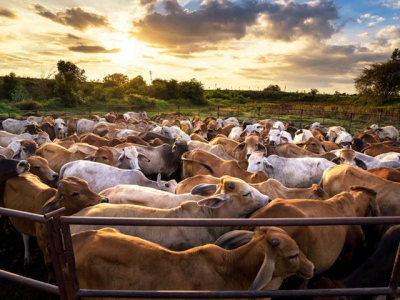Brazil: Low feed prices could expand feedlot cattle production

Increasing global and domestic demand is expected to boost Brazil’s production of pork and beef, while low and stable feed prices may support the growth of feed use in cattle production.
The US Department of Agriculture (USDA) released details regarding livestock production in Brazil and the potential expansion in the numbers of cattle raised on feed in an agricultural specialist’s report.
Overall, the anticipation is that beef production in Brazil will increase 3% to about 10.5m metric tons in 2020, the specialist said. The growth is driven by exports – predominantly to China and Hong Kong – along with increased domestic demand.
There is an anticipation that meat production in a feedlot system could double in the next five years, he said. Confinement feeding has already grown by about 12%.
“Feedlot operations are projected to increase by over 5% in 2020 from 5.5m to nearly 6m head,” he said. “The increase is mostly attributed to higher cattle prices and lower feed costs. Most of the increase in feedlots are in the Center-West region, which is close to higher supplies of silage.”
Pork production is expected to reach a record high of 4.1m metric tons based on stable feed prices, the strength of the export market to China and growing domestic demand, he said.
“Production factors for both beef and pork, such as stable feed costs due to a projected bumper soybean and corn crops, and increased carcass weights, are fueling optimism for both industries next year.”
“The expected growth of the Brazilian economy in 2020 by over 2%, with declining inflation and unemployment rates, and higher consumer purchasing power, supports optimism in the animal protein sector in Brazil,” the specialist said. “However, the trade dispute between the United States and China and exchange rate fluctuations remain uncertainties for the industry.”
Beef production
Calf crop production in 2020 is expected to increase by about 2% as producers continue to expand herds, the specialist said.
“Cattle production will continue to be supported by several government programs, such as subsidized agricultural credit for pasture improvement, recovery of degraded pastures, crossbreeding programs using imported cattle genetics, proper nutrition, health and increasing use of reproductive technologies,” he said. “The projected weather pattern for 2020 calls for more precipitation benefiting pastures in the Center-West regions, which account for about 40% of the cattle production in Brazil.”
Livestock production in Brazil remains mostly grass-fed with feedlot production accounting for about 10% of meat generated, he said. However, there could be an increase in feedlot-style production to reduce cattle weight loss during dry periods.
“Feedlots are concentrated in Sao Paulo state and the Center-West states of Mato Grosso, Goias, and Mato Grosso do Sul,” he said. “These four states alone account for 73% of all feedlots in Brazil. Semi-confinement systems were cattle are fed grain rations while on pasture (primarily in the dry season) are also increasing and concentrated in the Center-West.”
Beef production in 2020 is forecast to increase based on factors including record exports in 2019, domestic demand, heavier carcass weights following breed development work and increased feedlot production, the specialist said.
Exports in 2020 are anticipated to expand by 7% with markets including China and Hong Kong along with Egypt, Saudi Arabia, UAE, Russia, Iran and Turkey, he said.
“Local traders are optimistic regarding an increase of Brazilian beef exports to the Muslim world,” he said. “Currently, there are over 100 cattle slaughter plants in Brazil approved under the halal system.”
Swine stats
The pig herd in 2020 is expected to grow by 3.5% based on record pork exports and domestic use, the specialist said. Producers are anticipated to have low production costs and high exports following the effects of African Swine Fever (ASF) in China and Europe.
The cost of hog production has been falling as nutrition costs drop, he said.
“The outlook for the near future is for some stability in the cost of production, due to a projected higher corn and soybean crops,” the specialist said. “Independent hog producers, however, are skeptical about the outlook for reduced corn prices as Brazil is expected to export record amounts of corn in 2019 and 2020 due to higher world demand and the competitive prices of Brazilian supplies.”
Total pork production is set to increase based on global demand and expanding domestic consumption, he said.
Related news
 Research center focuses on improving cattle forage
Research center focuses on improving cattle forage Improved understanding of how a tropical forage grass passes its traits may allow for faster varietal development work and provide improved feeds for cattle
 New in vitro tool estimates ruminal protein degradability
New in vitro tool estimates ruminal protein degradability Meeting protein requirements and improving nitrogen efficiency in cows under different physiological conditions can be more precise using new tool for diet
 Five tips for making high-quality flaked corn for cattle
Five tips for making high-quality flaked corn for cattle Maximizing the surface area of grain to rumen microbes is a critical first step in optimizing performance in cattle.